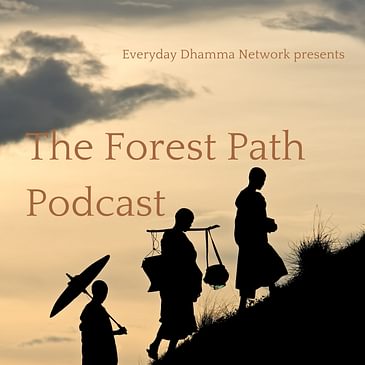
Forest Path Podcast
Powerfully insightful teachings and practical advice from the deepest meditators and wisest teachers of the forest tradition of Theravada Buddhism.
Powerfully insightful teachings and practical advice from the deepest meditators and wisest teachers of the forest tradition of Theravada Buddhism. These translations are narrated so you can have the audio on your phone or PC wherever you go and can listen to them whenever you want.
Reviews:
Why Are We Here? | Ajahn Chah
This episode is a talk given by the Thai forest meditation master Ajahn Chah and is titled “Why Are We Here?” . It was first publish as part of the book “The Collected Teachings of Ajahn Chah” which is made available by Aruna Publications. You can find links to the original text in the description b...
Only The World Ends (part 2) | Ajahn Tate
In this episode of the Forest Path Podcast I’ll be completing the narration of the teaching “Only the world ends” by forest meditation master Venerable Ajahn Tate. This is part two of two episodes. Stay tuned to listen to the concluding part of this teaching by a true meditition master of the Thai F...
Only The World Ends (part 1) | Ajahn Tate
In this episode of the Forest Path Podcast I’ll be narrating an extended Dhamma teaching by the great forest meditation master Venerable Ajahn Tate. It is titled “Only the world ends”. It’s a very well rounded teaching and goes in to some depth about samadhi. Because it is so long, I’ll be breaking ...
Kammaṭṭhāna - the basis of work - Ajahn Maha Boowa
This episode is a talk given by the Thai forest meditation master Ajahn Maha Boowa and is titled “Kammaṭṭhāna”. It was first publish as part of the book “kammaṭṭhāna - the basis of practice” which was translated by monks at Wat Pah Ban Taad. The Pali work kammaṭṭhāna literally means “the pl...
Making The Heart Good | Ajahn Chah
This episode is a talk given by the Thai forest meditation master Ajahn Chah and is titled “Making the Heart Good”. This talk was first publish as part of the book “The Collected Teachings of Ajahn Chah” which is made available by Aruna Publications. You can find links to the original text in the de...
Listen Well | Ajahn Fuang Jotiko
This episode is a talk given by the Thai forest meditation master Ajahn Fuang Jotiko and is titled “Listen Well”. This talk isn’t just about listening the teachings, but also about developing our meditation so that we can develop our minds and achieve Awakening.It was first published on the website ...
The Marvel of the Dhamma | Ajahn Maha Boowa
This episode is a talk given by the Thai forest meditation master Ajahn Maha Boowa and is titled “The Marvel of the Dhamma”. It was first publish as part of the book “Straight from the Heart” which was translated by Thanissaro Bhikkhu. Copyright © Venerable Ācariya Mahā Boowa Ñāṇasampanno 1987 This ...
Even One Word Is Enough | Ajahn Chah
This episode is a talk given by the Thai forest meditation master Ajahn Chah and is titled “One Word Is Enough” . It was first publish as part of the book “The Collected Teachings of Ajahn Chah” which is made available by Aruna Publications. You can find links to the original text in the description...
Consciousness | Ajahn Lee Dhammadharo
This episode is a talk given by the Thai forest meditation master Ajahn Lee Dhammadharo and is titled “Consciousness” . Less than a year before Ajaan Lee's death, some of his students began tape-recording his Dhamma talks. The following talk is one of the nine for which we have transcripts from the ...
The Language of the Heart | Ajahn Maha Boowa
This episode is a talk given by the Thai forest meditation master Ajahn Maha Boowa and is titled “The Language of the Heart”. It was first publish as part of the book “Straight from the Heart” which was translated by Thanissaro Bhikkhu. Links The Forest Path Podcast Everyday Dhamma Network Copyright...










